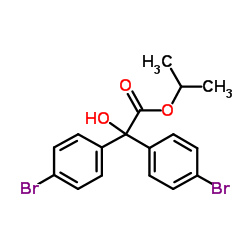bromopropylate

bromopropylate structure
|
Common Name | bromopropylate | ||
|---|---|---|---|---|
| CAS Number | 18181-80-1 | Molecular Weight | 428.115 | |
| Density | 1.6±0.1 g/cm3 | Boiling Point | 504.5±45.0 °C at 760 mmHg | |
| Molecular Formula | C17H16Br2O3 | Melting Point | 77ºC | |
| MSDS | Chinese USA | Flash Point | 258.9±28.7 °C | |
| Symbol |

GHS07 |
Signal Word | Warning | |
|
Gas chromatographic determination of residues of bromopropylate and two of its degradation products in honey.
J. Assoc. Off. Anal. Chem. 67(5) , 896-901, (1984) An analytical procedure is described for determination of residues of bromopropylate (BP) and its main degradation product 4,4'-dibromobenzophenone (BBP) in honey. The method also allows the determination of 4,4'-dibromobenzilic acid (BBA), a potential interm... |
|
|
Rapid multi-residue method for the determination of azinphos methyl, bromopropylate, chlorpyrifos, dimethoate, parathion methyl and phosalone in apricots and peaches by using negative chemical ionization ion trap technology.
J. Chromatogr. A. 996(1-2) , 181-7, (2003) A rapid, selective and sensitive multi-residue method for the determination of six common pesticides in stone fruit samples is described. The proposed method involves the extraction of the pesticides with the use of acetone solvent followed by liquid-liquid p... |
|
|
Promotion of altered hepatic foci development in rat liver, cytochrome P450 enzyme induction and inhibition of cell-cell communication by DDT and some structurally related organohalogen pesticides.
Carcinogenesis 11(8) , 1413-7, (1990) The organochlorine pesticide 1,1'-(2,2,2-trichloroethylidene) bis(4-chlorobenzene) (DDT) and four structural analogues (bromopropylate, chlorobenzilate, dicofol and fenarimol) were investigated for their ability to inhibit gap junctional intercellular communi... |
|
|
Disappearance of bromopropylate residues in artichokes, strawberries and beans.
J. Environ. Sci. Health B 26(3) , 323-32, (1991) Residues of Bromopropylate were determine in artichokes, strawberries and beans after foliar spray of acaricide at two rates. The rates used were 1 g/l formulated product (normal recommended) and 1.5 g/l. The residue levels of bromopropylate in the three crop... |
|
|
Bromopropylate: induction of hepatic cytochromes P450 and absence of covalent binding to DNA in mouse liver.
Toxicol. Appl. Pharmacol. 129(1) , 155-62, (1994) Oral administration of benzilic acid ester-based acaricide bromopropylate at daily doses of 3, 15, 100, and 300 mg/kg body wt to young adult male Tif:MAGf mice for 14 days caused slightly increased liver weights in the high-dose group. A dose-dependent increa... |
|
|
Determination of impurities in pesticides and their degradation products formed during the wine-making process by solid-phase extraction and gas chromatography with detection by electron ionization mass spectrometry. II. Bromopropylate, trichlorphon, parathion-methyl and tebuconazole.
Rapid Commun. Mass Spectrom. 18(22) , 2629-36, (2004) The presence of degradation products of bromopropylate, trichlorphon, parathion-methyl and tebuconazole in white and red wines elaborated from musts spiked with commercial formulations of the pesticides was studied. Must and wine were subjected to solid-phase... |
|
|
[Current findings in the chemotherapy of varroatosis].
Berl. Munch. Tierarztl. Wochenschr. 98(9) , 303-6, (1985)
|
|
|
[Field trials to control the bee tick Varroa jacobsoni with Folbex-VA-NEU and biotechnical measures on a bee farm in Tunisia].
Berl. Munch. Tierarztl. Wochenschr. 96(7) , 239-41, (1983)
|
|
|
Evaluation of immunoassays as an alternative for the rapid determination of pesticides in wine and grape samples.
J. AOAC Int. 93(1) , 2-11, (2010) The main objective of this paper is to address the performance of immunochemical assays for the detection of the residues of three pesticides [atrazine, bromopropylate, and 2,4,6-trichlorophenol (TCP)] in real winery samples, such as wine, grapes, and grape j... |
|
|
Combination of solid-phase extraction with dispersive liquid-liquid microextraction followed by GC-MS for determination of pesticide residues from water, milk, honey and fruit juice.
Food Chem. 204 , 289-97, (2016) In this work, an effective preconcentration method for the extraction and determination of traces of multi-residue pesticides was developed using solid-phase extraction (SPE) coupled with dispersive liquid-liquid microextraction and gas chromatography-mass sp... |